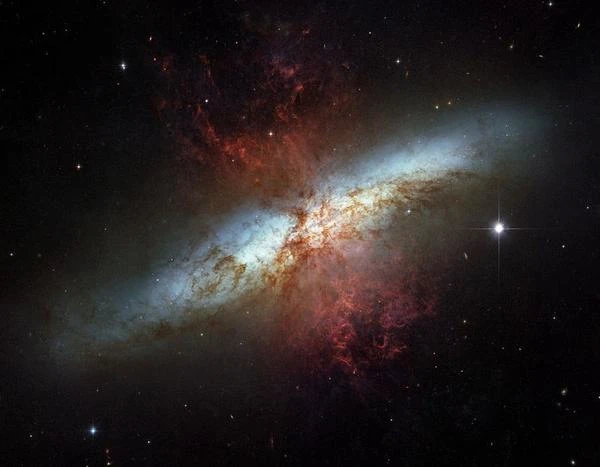
Galactic Type: M82 is classified as an irregular galaxy, although some consider it a deformed spiral galaxy. Its morphology is disturbed, likely due to gravitational interactions with M81.
Shape and Dimensions: It has a very elongated shape, hence its nickname "Cigar Galaxy." Its apparent angular size is about 11.2 x 4.3 arcminutes, corresponding to a physical size of about 37,000 light-years in length.
Active Core: The core of M82 is particularly active and rich in gas and dust. It contains many star-forming regions and recent supernovae.
Star Formation: M82 is a starburst galaxy, meaning it has an extremely high star formation rate, far exceeding that of normal galaxies. This rate is estimated to be about ten times that of the Milky Way. The central region of the galaxy is the site of intense star formation, largely triggered by gravitational interaction with M81, which has caused waves of compression in the interstellar gas.
Galactic Superwind: The central region of M82 hosts a powerful galactic superwind, a flow of hot, ionized gas expelled at high speed (up to 1000 km/s) perpendicular to the galactic disk. This wind is fueled by supernova explosions and stellar winds from massive stars. This phenomenon is visible as glowing filaments of H-alpha emission gas, extending thousands of light-years.
Luminosity: M82 is the brightest galaxy in infrared light in the sky, indicating an abundance of dust heated by massive star formation. It emits about five times more infrared energy than the Milky Way.
Gravitational Effects: The proximity of M82 to M81 has had significant gravitational effects. The tidal forces between these two galaxies have likely disturbed M82, triggering the starburst activity observed today. It is probable that the two galaxies have approached each other multiple times, with each pass intensifying star formation in M82.
Matter Flows: There is evidence of material exchange between M81 and M82, including gas flows that may extend between them.
Infrared and Submillimeter: The Cigar Galaxy has been extensively studied in infrared and submillimeter wavelengths, revealing details of star-forming regions hidden by dust.
X-Rays: X-ray observations show emissions from the inner regions, linked to phenomena such as supernova explosions and intermediate-mass black holes.
Radio Astronomy: Radio emissions from M82 reveal the presence of many supernova remnants and dense gas cores in the galaxy.
M82 is often used as a laboratory to study star formation processes under extreme conditions. Its status as a starburst galaxy makes it a key object for understanding how galactic interactions can influence galactic evolution.
Supernova SN 2014J: A Type Ia supernova, SN 2014J, was discovered in M82 in January 2014, providing a unique opportunity to study such an event in a starburst galaxy.
In summary, the Cigar Galaxy is a fascinating example of a starburst galaxy where gravitational interaction with a neighboring galaxy has triggered an intense episode of star formation. Its dynamic activity, galactic superwinds, and intense radiation make it a major object of study in extragalactic astronomy.